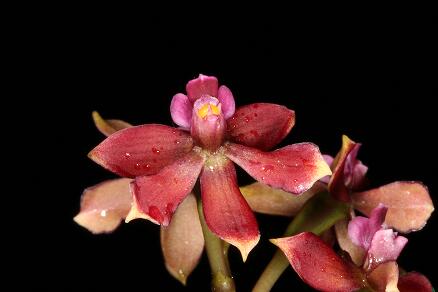Orchidaceae
Prosthechea

Kingdom: Plantae Rank: Genus Parent: Orchidaceae Status: Valid
Morphological Description
Diagnosis:
Plants of Prosthechea most commonly have spindle-shaped pseudobulbs with a distinctly stalked base (stipitate). The non-resupinate flowers are often brittle. Resembling flowers of some species of Epidendrum, the lips of Prosthechea are not fused to the column for its length and are easily deflexed. The plants differ from Encyclia by having succulent pseudobulbs that lack the strong fibers found in Encyclia.
1 One leaf per growth; flowers produced on developing
growths. ....................................... P. aemula
1’ More than one leaf per growth; flowers produced on mature
pseudobulbs. ........................................... 2
2(1’) Inflorescences subsessile, less than 2 cm long. ..........
............................................... P. pygmaea
2’ Inflorescences pedunculate, more than 5 cm long. ....... 3
3(2’) Sepals and petals white or yellow, unmarked or with
longitudinal stripes. .................................. 4
3’ Sepals and petals solid brownish red or heavily marked
with transverse spots and bars. ........................ 5
4(3) Lip unlobed, obtuse; sepals and petals with longitudinal
purple stripes. ............................ P. abbreviata
4’ Lip 3-lobed, acuminate; sepals and petals unmarked. ......
........................................ P. grammatoglossa
5(3’) Lip distinctly 3-lobed. ................................ 6
5’ Lip unlobed or obscurely 3-lobed. ...................... 7
6(5) Sepals and petals transversely barred with brown, if the
bars coalesced then the apices clear golden yellow; flowers smaller, the lip to 0.6 cm wide. ..... P. farfanii
6’ Sepals and petals solid dark brownish-rose; flowers larger, the lip to 1 cm wide. ................... P. fusca
7(5’) Lip only slightly longer than the column; pseudobulbs
usually less than 40 cm long. ............. P. crassilabia
7’ Lip distinctly exserted, about twice as long as the
column; plants quite robust, the pseudobulbs usually more
than 50 cm long. .............................. P. tigrina
Vegetative Morphology
Habit: Caespitose to trailing epiphytes, lithophytes and terrestrials. Pseudobulbs cylindric to ovoid, usually compressed, subtended by small non-foliaceous bracts.
Leaves: Leaves one to several, apical, strap-shaped, acute or minutely notched at the apex.
Reproductive Morphology
Inflorescence: Inflorescences terminal racemes, rarely panicles, subsessile or pedunculate, the floral bracts minute.
Flowers: Flowers usually not resupinate. Sepals and petals subsimilar, subequal, free, spreading. Lip unlobed to three-lobed, clawed, often cupped, usually with a basal callus that conforms to the undersurface of the column, sometimes with additional keels on the lip blade. Column cylindric, flattened on the undersurface, usually three-toothed at the apex, free from the lip, without a foot; pollinia 4, in two equal pairs, on minute caudicles.
Other
Notes: Formerly included in Encyclia, the genus Prosthechea is generally defined in a very broad sense by modern authors based on DNA studies. A viable alternative is defining Prosthechea in a narrow sense (see Withner, C. L. 2001. An overview of the genus Prosthechea, sens. str. Orchid Digest 65(2):78-81). When so interpreted, all the species in the flora are referable to Anacheilium.